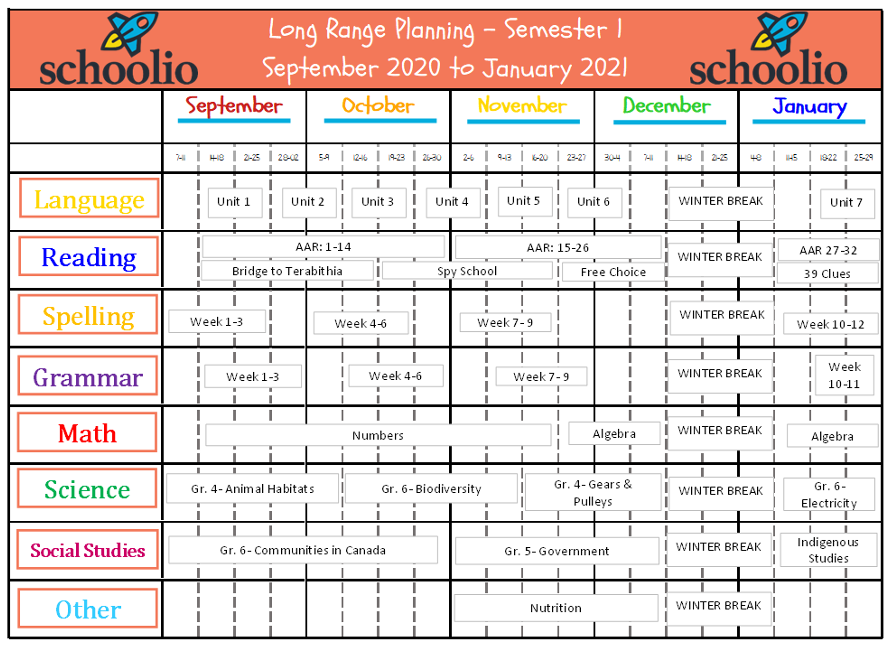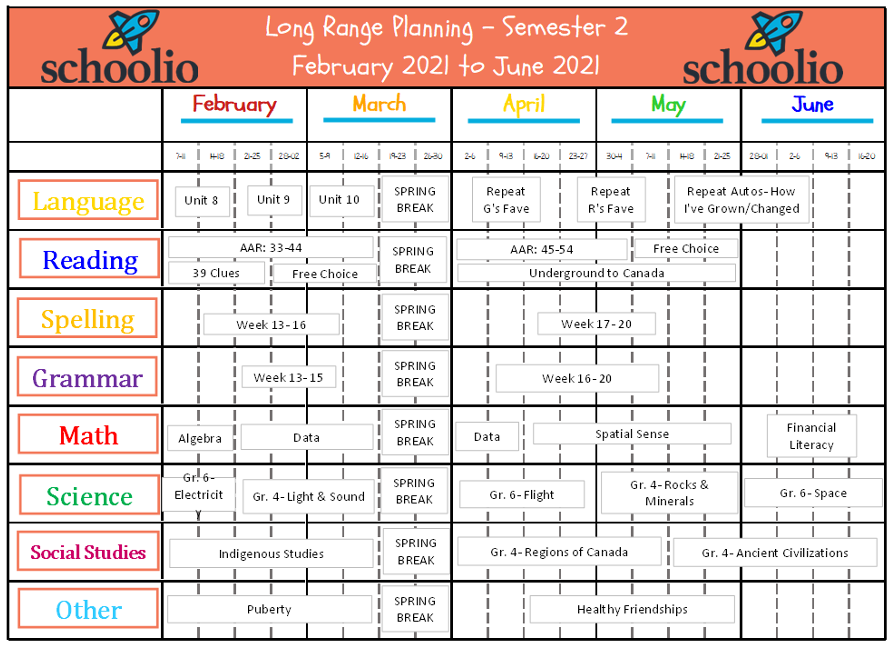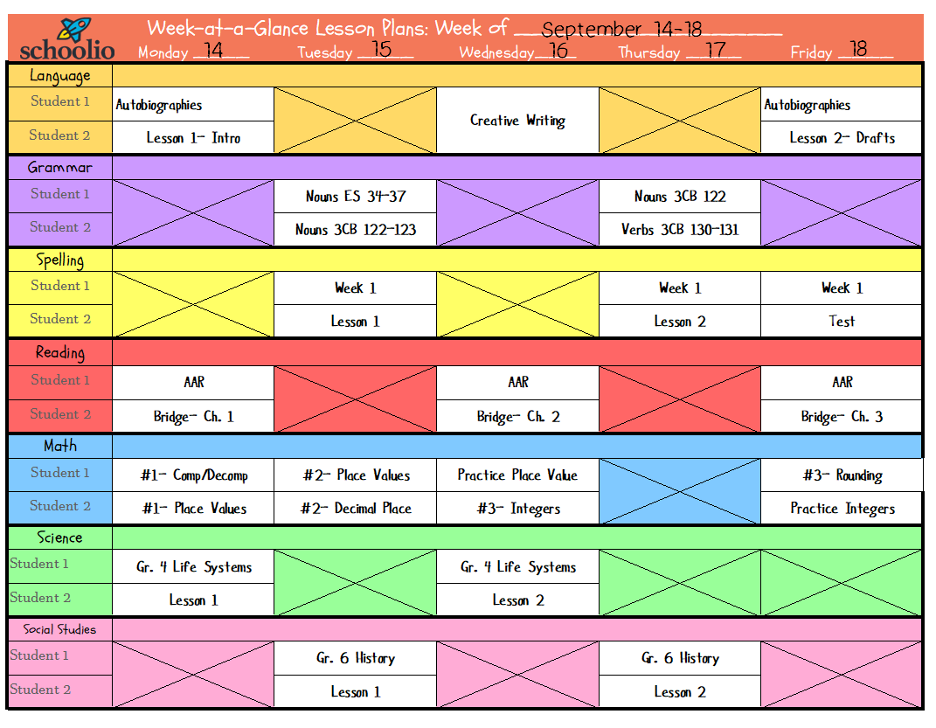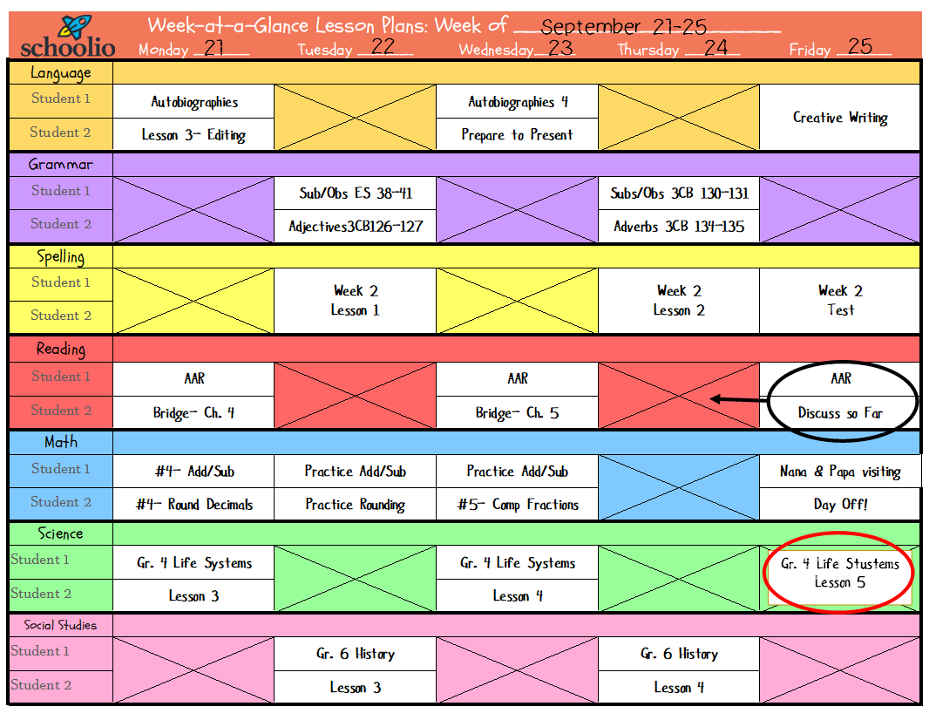Let’s Talk About: Planning
When I talk about planning, I’m planning in two different ways: Long-Range and Short-Range. My Long-Range plans are my overall scope for the entire year, which I do before the year begins. My Short-Range is planning week by week, which I plan continuously all year long.
Let’s start with Long-Range planning. First I make a list of all the units I’m going to cover within each subject. If you’ve purchased an all-in-one curriculum like Schoolio, you basically already have this list in your table of contents.
I have two kids, and for efficiency of teaching, I teach them both all of each other’s Science and Social Studies. What does this mean? Well life gets crazy if I’m trying to teach my sixth grader a unit on Electricity in Science at the same time I’m trying to teach my fourth grader a unit on Animal Habitats, so instead they both learn Electricity, and then they both learn Animal Habitats.
When we do the sixth grade unit, my focus for understanding the content is on the sixth grader, for my fourth grader this is an introduction to a topic she’ll understand better in two years. But there’s no reason she can’t participate and learn now. When we turn to the book work, I either photocopy it for my fourth grader (if I think it’s level-appropriate for her), or they work on it as a team with the sixth grader at the helm doing the writing.
When we do the fourth grade unit, my focus for understanding the content is on the fourth grader. For the sixth grader this is a review of a topic he learned two years ago. But there’s no reason he can’t participate and get refreshed on the topic. When I ask questions and when we move to the book work, I remind my sixth grader to let the fourth grader have a go at most of the questions before he provides any answers.
So all that to say, for two kids I am Long-Range planning twice the number of subjects.
The reason long range planning is important is because you want a general idea of how all your subjects fit in to your year. You may have certain subjects you want at certain times of the year (for example, if you’re doing a unit on plants and you want to grow something, you may want to save that unit for the spring), and you also don’t want to get so caught up in one subject that you run out of time at the end of the year for other subjects you were excited about. You also don’t want to move too quickly and complete everything you wanted to for the school year in March, only to wish you’d gone deeper on the subjects you’ve already finished.
Here is an example of a Long Range plan on our Schoolio template for my grade 4 and grade 6 kiddos:


Sometimes I space certain subjects out, and leave entire weeks blank. These are usually my kids’ least favourite topics, so I like to give them a break from it here and there to refresh their minds and not drain them.
I also like to wind down a term by dropping subjects gradually in the weeks before a break, and warm up to a new term by gradually adding subjects after a break.
I also know certain weeks (like mid-November all the way until the new year; or when the weather turns nice in mid-May until end of June) are going to be extra busy with travel, family, or field trips. I never want to have to turn down an experimental, hands on learning opportunity like a field trip because I feel like we’re “behind” in traditional academics.
Once I have my Long-Range Planning done, I’m ready to start my year feeling more prepared in the knowledge of what subjects we are covering, and when. If you’re writing your own material, or you’re trying to figure out how many days per week you want to do a subject, these are easier to backwards plan from this Long-Range plan. If your Science is 10 lessons and you want to complete it in 5 weeks, you want to do Science twice a week. If your Science is 20 lessons and you want to complete it in 5 weeks, you need to do Science 4 days a week, and so on.
Next step is Short-Range planning, or weekly planning. One thing I will say about weekly planning is this: Do NOT plan it too far in advance! You never know when something (or several things) will mess up your best laid plans. Maybe a math lesson just isn’t clicking with your child and you find yourself needing a bunch of practice days before moving on to the next concept. Maybe a spontaneous field trip comes up, someone needs a sick day, or your kids are loving the science topic and you do two lessons in one day. You just never know! And these days WILL happen. Planning weeks and week in advance will cause you to have to redo your schedule many times. I’m a planner by nature and as a teacher I learned to have most of the year laid out well in advance, and I’d love nothing more than to plan my entire year down to the hour, then laminate that sucker and put it on my wall. But in homeschool that just doesn’t work. Trust me on this. I’ve learned this lesson over the years, and now I never do more than two weekly plan templates at a time. Even then I sometimes have to make changes, and they’re a scribbled mess by the end of the two weeks.
Here’s an example of two weeks of weekly planning for my two children:

Week One is very straight forward. I’ve used my purchased curriculum and I’ve slotted in the prescribed lessons in the recommended order. Easy peasy.
As you can see for some lessons my kids will do the same material and for others they will use other material.
Like this:
- Their Language (writing) have the same topics, I just have different expectations of the level of work handed in from each of them. This is really helpful to have them both working on “autobiographies” on the same weeks, even if they have very different skill levels in writing.
- Both kids are doing Gr. 4 Life Systems in Science.
- Both kids are doing Gr. 6 History in Social Studies.
For the subjects that they have different work, like math and grammar, I like to handle them one-on-one. This looks like, one child has free time, or I’ve assigned some silent reading, while I work with the other child alone. It really depends on the kids and their strengths in various subjects. For us, my kids can each work on their own grammar at the same time, because I know only one of them is going to need much help from me. But when it comes to math I want to work with them separately, because I know they will both need help from me. Remember, you are not a ping pong ball!

Week two is starting to show off the beauty of homeschooling.
First a note, see how I plan in practice days, especially in Math? Not every day needs to be a new lesson, in fact, it shouldn’t be, or you’re not going to have all the information well understood and solidified. After many years of teaching my own children, I’m getting more familiar with guessing where they will need more practice and where they won’t. This is based on their own unique needs, but even with experience you just never know. In Week One I guessed my sixth grader would need an extra day to practice integers. It turned out he didn’t. In week two I thought my fourth grader would need two days to practice adding and subtracting to 10,000, it turned out she only needed one day of practice. Yes, here we are in week one and two, and we’re already veering wildly off course. Welcome to homeschooling!
And then, Nana and Papa ask to visit us for the weekend, arriving on Friday – yay! There’s no academics more important than quality family time, so, out with the plan again!
Here’s the changes I made to accommodate their visit:
- I switched Creative Writing (usually on Wednesdays) with the final lesson for autobiographies (meant to be on Friday) so that the kids can finish up their autobiographies before Nana and Papa visit, and then I’ll have them prepare to present them orally to their grandparents. The grandparents will LOVE it and the kids get to practice an oral presentation AND share their hard work – triple win! And while they do independent creative writing on Friday morning, I can clean some of the house in preparation for guests.
- I’m going to bump our reading time slot on Friday over to Thursday. I’m doing this so I have more free time to prep for guests Friday morning. No big deal, that’s an easy change that makes my life easier.
- We will do our spelling test as scheduled, that doesn’t take much time.
- Let’s just straight up cancel math it’s a) Friday and b) company! Doing Math is just nuts at this point.
- We’re going to add an extra Science lesson on Friday afternoon Because the kids love Life Systems and I know Nana and Papa would love to watch a lesson in action. This is a fun one I know the kids will be engaged with.
One of the greatest parts of homeschooling is flexibility. We can take Friday off entirely if we want to and just be present with the grandparents, and the kids won’t “miss” what’s happening in the classroom. Because the classroom waits for them. Remember never force your life to fit around school, make homeschool fit your life, because life is what’s truly important.
Lindsey Casselman is the founder of Linden Tree Learning and a valued team member here at Schoolio. She not only writes the curriculum for your children, she also homeschools her own children and manages her hobby farm. This woman wears a super-hero cape under her clothes as she works hard to ensure that every parent enjoys their homeschool journey.
Would you like a copy of these amazing planning templates? Simply fill out the form below with your name and email.
In the message section write “Would like free templates” And the templates will be emailed to you in pdf form.




